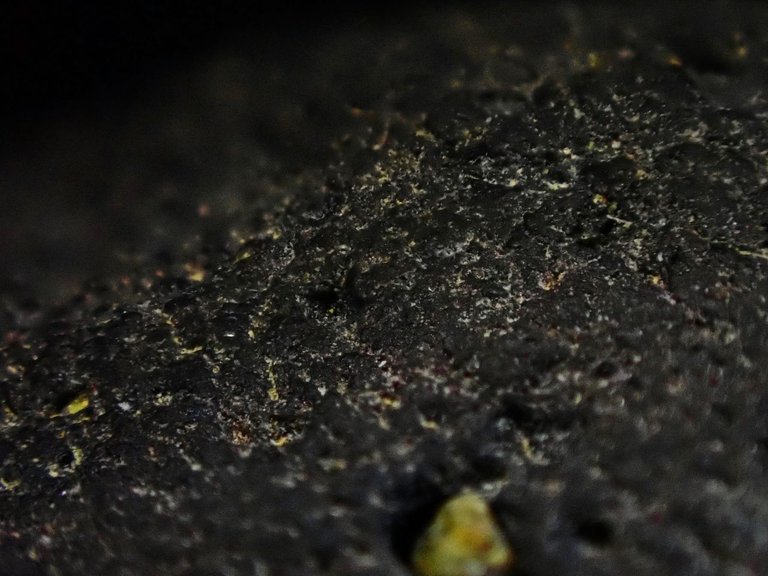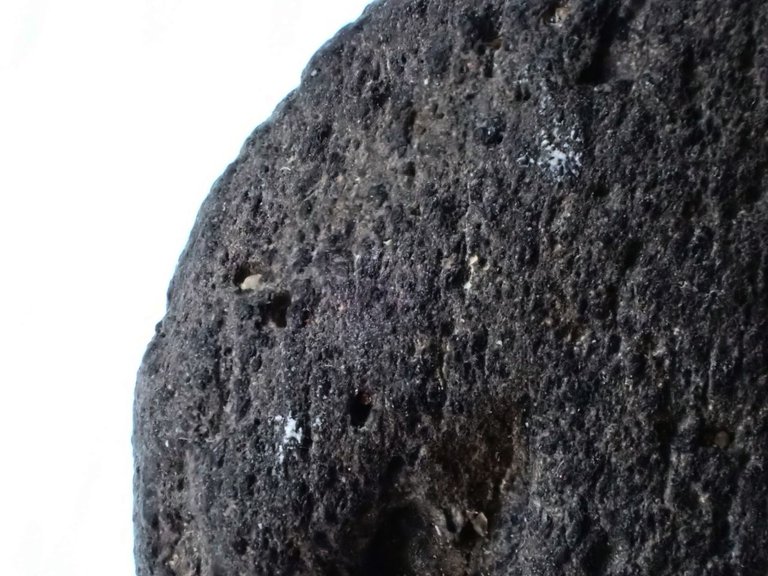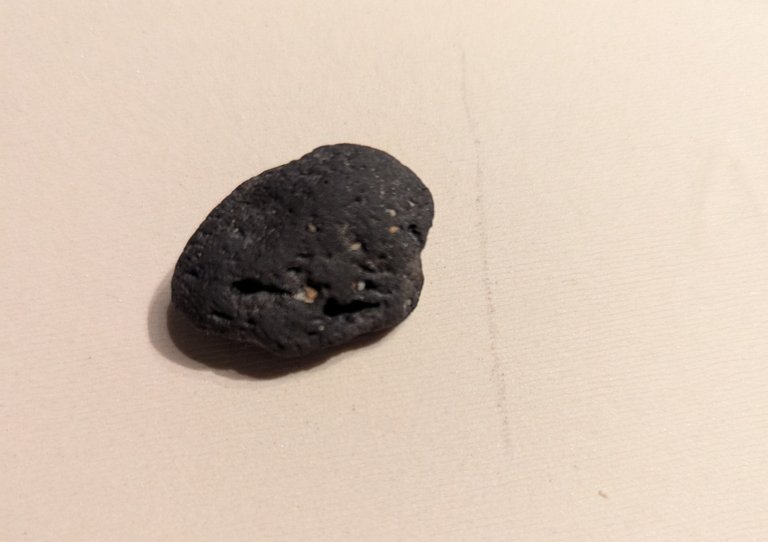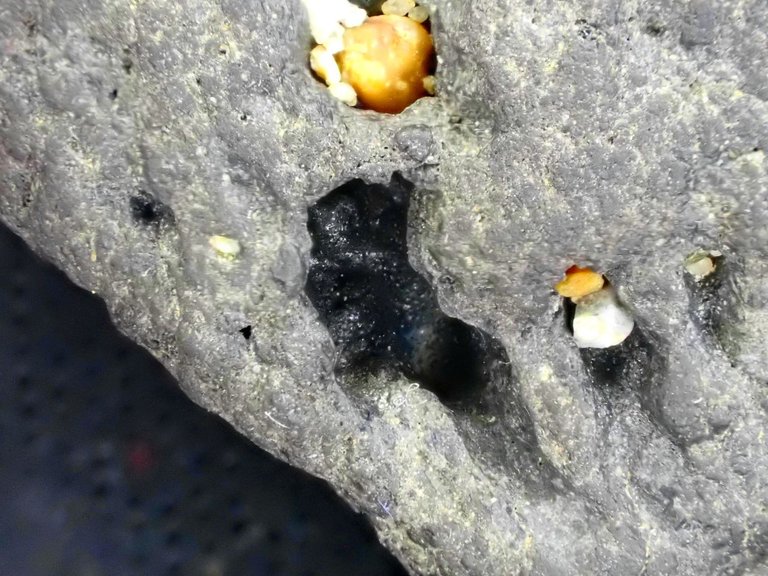We recently had a bomb cyclone churn along the coastal areas of southwestern BC. While the eye of the storm remained offshore and did not land a knock out punch on the continental landmass, it did land plenty of hits thanks to its outer spiral arms sweeping around with a right hook.
After the storm, I went out for a walk to check things and see if I could find any interesting sights. The ocean was relatively calm and massive clouds whirled overhead from the southwest.
While most of the coast is rocky around these parts, there are sandy beach strips scattered along the shoreline with little to no rocks in sight. I sometimes find interesting detritus like seashells, dead crabs, and seaweeds along the water’s edge, where the sand is still wet from the ebbing tide.
I found nothing remarkable as I slowly made my way along the sand, scanning the edge where the waves had deposited a small trail of broken seashells. I was halfway along the way, when I happened to look down and saw a black rock on the sand. It caught my attention because there were no other rocks around. It also had a striking black colour that looked more like charcoal. For a moment, I thought it was a piece of charred wood that had been carried by the waves, but as soon as I picked it up, I realized that it was actually a rock- though it felt lighter than usual. Although it looked ordinary, there was something about it that caught my attention, so I put it in my pocket and took it home.

The light makes the rock look lighter than it actually is
Days later, I was messing around with Google lens, which I use to ID plants from time to time. I decided to use it on an interesting rock that I had found on a trip to the island. Lens gave me some fascinating results (which I will share on another post). Then remembering the black rock that I had found on the beach, I decided to point the camera at it and use Lens to identify it.
The result came in…
Tektite meteorite!

I felt a surge of adrenaline as every fibre of my nervous system went into electric excitatory mode.
Was I really holding a space rock in my hand? A piece of another planet? The moon? An asteroid? Perhaps this was the remnant of our primordial universe.

I went into frantic action. I needed a way to corroborate this finding, but I wasn’t really looking forward to doing the painstaking research on the subject of rocks. I’ve had enough of geophysics to last me a lifetime, thank you very much. But how could I leave this mystery alone?
I needed a quick and dirty method of determining if I indeed had a shooting star in my hands or just a plain old rock.
Theory and preliminary results
If it was quick and dirty that I needed, then I knew just the place to look for information: Youtube. Video content creators usually get straight to the point, so they're great for initial exploration of a topic. As I had suspected, a quick search provided me with the results that I needed. A lot of the information that follows was gleaned from those videos (as well as other sources), and I add a link to the resources at the end of this post.
One telltale sign that a given rock is from outer space is the presence of iron. A fast way to find out if a rock contains unusual amounts of iron is through the use of a magnet. By putting a magnet close to the rock, one can see if they become attracted to each other. If there is an attraction, then the rock contains iron and is potentially a meteorite.

I purchased this X at a secondhand store and conveniently the rock fit right on top leaving a gap in the middle for demonstration purposes. The X is made of a velvety black material, and the rock appears just as black
As it turns out, I had some fridge magnets laying around, so I grabbed a small one and placed it on the table.
Then I grabbed the rock and brought one narrow end close to the magnet.
Nothing happened.
I turned the rock between my fingers and placed the broad side on top of the magnet. Slowly, I lifted it.

Imagine my delight when I saw the magnet clinging to the rock!
Joy!
My eyes focused on the black rock. I grabbed it. Turned it here and there, marveling at its black surface. Could it be? Was this a messenger of the starry heavens?
I tested it again and again. The narrow sides did not pick up the magnet, but the part where most of the mass was accumulated was able to lift it. It wasn’t a strong pull, but it was strong enough to hold it aloft.

But wait a minute. I mentioned that given its rich iron content, the rock should seem heavier than usual, but my rock felt somewhat lighter than usual. perhaps it was not fully made of iron but contained some other material in the mix. I needed to conduct more research to try to get some answers. Regardless of those answers, I was glad my instincts had been right. I had found something special, and it was now here on my desk.
Background
I’m not an expert on meteorites by any stretch of the imagination. Everything that you read in the next few paragraphs is information obtained from various sources, including the aforementioned Youtube videos. So, please take everything I write with a grain of salt and consider it an X file.

Meteorites are extremely rare, so the chances that a found rock is a meteorite is extremely low. They are generally classified into three categories: stony, iron, and stony-iron. Stony meteorites are the most common, the iron ones are rare, and the stony-iron kind is the rarest of them all. Given that the rock I found appeared to have some iron in it, we can rule out the stony meteorite category because this type of meteorite is composed of mainly silicates. Iron meteorite are heavier than they look, but the rock I found felt somewhat light, possibly ruling out the iron category. This left me with the most rare category: stony-iron.
Google lens identified the rock as tektite meteorite. A tektite meteorite is not a real meteorite. It is formed when a meteor strikes the ground, and the powerful impact causes an explosion of molten rock. This material is mainly composed of silicates with low metallic content, so it’s basically molten glass flying through the atmosphere and which then falls back to earth in various shapes that quickly cool and solidify on the way down.

I inspected the rock, and it did not feel like glass at all in texture or weight, though under magnification I could spot glassy surfaces, especially when I moved it under the light.

It's difficult to capture with the camera but with the naked eye, the surface looked smooth and glassy edges can be seen
Holding the rock in my hand, it did not feel like it was made of glass, but some other rough material, including iron. Without any further tests, I could not rule out the possibility that the rock in my hands was indeed a tektite meteorite, but some of its characteristics contradicted this hypothesis.
Surface features in favour of extra-terrestrial origins
There are other characteristics that can help one identify a possible meteorite. As a meteor enters the atmosphere, it undergos a series of stresses that alters its physical, chemical, structural makeup. For example, the space rock heats up to such a high degree that the outer layer burns and turns black, becoming what is called a fusion crust. It was the unusual black colour what had called my attention to the rock on the sand in the first place. It looked burnt to me, and the idea of a meteorite did cross my mind.

As a meteor continues its trajectory as a shooting star across the heavens, the burning outer layer, or fusion crust, undergoes more transformation by cracking like an eggshell. Looking at the rock under the magnifying glass, I noticed that indeed there were fractures along the surface similar to those mentioned and shown on some meteorite samples that I found online.

There are small grooves like a cracked shell


The material on the rock appears to flow and be aligned in the same direction instead of randomly diffused throughout the rock.
The surface of the rock was rough and bumpy. One side was lighter than the other. Also, I noticed that when the light hit the rock edges at a certain angle, they looked ‘glassy’. This glassiness was consistent with the melting of silicate materials as a consequence of terrestrial entry (if indeed that is what happened). Further, when I looked closely at one of the cavities in the rock, I noticed a smooth glassy surface of even darker material than on the surface. It appeared to have “smooth bubbly” characteristics within the cavity. I used an Olympus TG6 camera in microscope mode to try to get some closeups of the interior walls to get a better look, but it was a difficult getting a clear photograph.



I mentioned that one side of the rock seemed lighter than the other side. At first, I though it was just dust, but under magnification, I realized the lighter material was not dust but part of the rock. In one of the videos I saw, they mentioned that the fusion crust can suffer abrasions that cause the burnt crust to peel off and reveal lighter rock material underneath. I examined the rock closer and sure enough, there were parts that appeared scratched off and showed a lighter material underneath.

There are two spots that show lighter material under the black layer. This is further evidence of a fusion crust
It was possible, I conjectured, that one side of the rock was actually showing the original rock underneath for some unbeknown reason.
Just a little pin prick
In another video, it was mentioned that you can sand off one part of the rock to see what lies underneath the black layer, and thus verify if it is indeed a fusion crust. I was not fully on board with that idea lest I do some major damage to a sample of rock that could be older than the planet itself. So, I did the next best harebrained thing, which was to take a push-pin and make a tiny hole in the rock to see what lay underneath the black layer (if layer indeed it was).

This image shows the nice black colour and small size of 3L x 2W x 1H cm.
I brought the sharp metal tip up to the rock and pressed lightly. The rock material felt a little soft at first but then hardened up. I rotated the pin on its axis while pressing more firmly against the rock. I began to notice a powdery grayish material accumulating around the edges of the hole. So, it was fusion crust after all! The colour of the layer underneath reminded me of moon regolith, opening the possibility that the rock might even be a piece of the moon.

The rock looks lighter than it is because of the light illumination from the camera, but the material under the black layer is indeed gray


I could only go so deep with the pin, and I was surprised that in spite of the rock’s lightness, it did not crumble between my fingers but felt sturdy, as if it was made of a strong but light piece of metal. When I looked closer, I noticed that where the tip of the tack had pressed against the material, a shiny surface was visible. It looked like pressing it with the pin fused the material and gave the surface a metallic sheen. Unfortunately, I could not rule out the possibility of contamination by the metal pin.


Surface features against extra-terrestrial origins
This was beginning to look like an X file episode with the possibility that I had a piece of extraterrestrial material in my possession- a shooting star, a slice of the moon, a souvenir from Mars, remnants of a destroyed planet, a broken asteroid, or some weirder specimen from beyond the known universe. My head was full of fancy notions.
I needed to summon my inner Agent Scully and take a more sober detached look at the specimen.

The first piece of evidence against the meteorite hypothesis was the holes on the surface. There were tiny pockmarks and irregular cavities throughout the rock surface, which to my untrained eye, appeared to be aligned in a direction at an angle perpendicular to the horizontal along the length of the rock.

In the Youtube videos, the content creators were adamant that if the rock had holes, then it could not be from outer space. I looked up images of meteorites online, and it wasn't long before I found meteorites with plenty of holes, so I’m not entirely convinced on this point, but I defer to their expert knowledge on the subject. Therefore, based on the presence of holes, the rock appeared to have a terrestrial origin.

Another test that was suggested in the videos was to find an unfinished porcelain surface and rub the rock on it. If it left a streak, then it was not a meteorite but was made on Earth. I just happen to have a brand new toilet, so without a further ado, I took the top off and rubbed the rock on the unglazed underside.
With light-to-medium pressure, the rock produced a light streak on the surface. I rubbed my finger on the streak, and the powdery residue easily came off, so the material did not stain the porcelain.

D'oh!
Although I cannot rule out the extraterrestrial origin or tektite hypotheses, according to my cursory research and based on these two pieces of evidence, it was more likely that the rock was made here on earth by some unknown process, possibly volcanoes or tectonic plates.

Additional observations
I had mentioned that the surface and the inside of the cavities contained a glassy material. I also discovered that if I shone a light back and forth, I could see the surface glitter, as if pieces of microscopic crystals were reflecting the light. Unfortunately, I cannot recreate this effect through photography. Could this shimmery material be olivine, which is found in both terrestrial and non-terrestrial sources? Some meteorites contain a mix of Magnesium-rich olivine and iron-nickel, likely from the Moon or Mars. The implications of this were head-spinning! They could’ve also been microlites formed during lava eruptions, but this was getting into some geophysical weeds that were beyond the scope of my investigation.

I had noticed that the magnet was attracted to the thicker portion of the rock but not the narrow edges. I was fooling around with my emergency radio that has a compass embedded on top. I grabbed the rock, brought the narrow tip close to the magnet, and saw the needle move slightly. So it seemed that the metallic material was diffused throughout the rock not just concentrated in the ‘core’. This further suggested that the rock was a mixture of heavy and light materials like a type of stony-iron meteorite called a mesosideriate with balanced portion of ferro-nickel and silicates.
One interesting aspect of the rock was its composition. Take a look at the following image and notice the smooth pebbly material. Under the right light, it looks glassy like molten glass, usually a sign of silicates.

Note the direction of the cracks and the alignment of loose material in the rock matrix
This type of mixed rock is called breccia, and it has an irregular texture composed of coarse fragments and glassy or pebbly lumps in a matrix of inter-growth material (or cement). They say that there are only 208 such meteorites and only seven stony-iron have actually been observed to fall. So, if my rock was a stony-iron meteorite, then it was on a class of its own. However, it should be noted that breccia rocks have terrestrial (volcanoes, tectonic boundaries, or hydrothermal vents) and extra-terrestrial sources such as a meteor, so the jury was still up in the air.


The two gray spots show the rock under the black layer
There were grains of sand lodged inside the rock cavities, and they seemed to have been there for a while. This was an indication that this rock had spent some time in the sand or perhaps an impact caused the sand to embed itself in the rock. This embedded sand was also possible evidence that the rock indeed came from the ocean and was not just dropped there by a person or an animal.

How did the sand get in there?

The sand particles are really lodged in the cavity. The walls inside are made of a darker material that glistens under the light, suggesting a silicate composition.
Conclusion
Based on my systematic analysis of the found rock, I have come to the conclusion that it is a piece of material from the hull of an ancient spaceship that crash-landed off the coast of British Columbia during the Pleistocene era in a botched invasion of planet Earth.

Or maybe not. I admit that my findings are a bit premature. Seriously though, based on my very amateur attempt at identifying this rock, the evidence suggests that it is of terrestrial origin, possibly a volcano or a tectonic boundary (of which there are many off the coast). I ruled out the tektite hypothesis because of the iron and not-so glassy appearance, but its teardrop shape could be evidence of a tektite ‘splashform’ usually found in such objects.

I did not attempt any further analysis to determine whether or not the rock’s origins were volcanic, tectonic, or some other process. There were certain aspects of the rock that left me mystified. What was it doing all by itself on that beach? Why did it have surface features associated with meteorites such as fusion crust, cracks, iron content, and so on? The answers could only come from a proper laboratory analysis, but I heard geologists were busy people and didn’t like anonymous gurus popping up in their email with sweet primordial promises of the early universe.

The hole made with the pushpin is visible in the white material located near the tip of the rock. Click to enlarge.
If the rock turns out to be a meteorite, experts say that about six percent originate from Mars, the Moon, or the asteroid Vesta. The majority appear to originate from the asteroid belt, but comets, other planets, and planetesimals are also possible sources of space debris. It could be as old as 4.5 billions years, leftover material from the early creation of our solar system. Perhaps it is something far more stranger.
I pick up the black rock and stare at it. The evidence points to it being terrestrial, likely a volcano or tectonic plate boundary creation. But then I see myself on that lonely strip of beach looking down at the black rock in the litter of broken seashells. How did it end up there all by itself?

Scenes flash in my mind. Rocky bodies floating in space- revolving, twirling, crashing and gliding across billions of years in the gravitational tides of the solar system. I see a shooting star entering the atmosphere and striking the ground in a powerful impact that ejects molten glass. That image is replaced with volcanic lava churning fragmented rocks, ejected in fiery explosions. I see tectonic plates pressing, sliding, grinding with unimaginable force against each other. I hear bubbling hydrothermal vents boiling in unexplored depths of the ocean with rocks churning like beef stew at a deli. I don’t have an answer to this tantalizing mystery that began so long ago. All I can do is hold the rock in my hand and wonder.


Resources
Meteorites: https://en.wikipedia.org/wiki/Meteorite
Mesosideriate meteorites
https://en.wikipedia.org/wiki/Mesosiderite
Tektites by the Meteorological Society
https://meteoritical.org/meteorites/tektites
Breccia rocks
https://en.wikipedia.org/wiki/Breccia
Microlites
https://en.wikipedia.org/wiki/Microlites
How To Identify a Meteorite
How to tell If the rock you found is a Meteorite
How to ID / Identify a Meteorite - Stone
How to identify a meteorite at home, the easiest 7 ways




Bravo!! You never fail to impress me.
I'd like the geologists on this platform to weigh in. That would be fascinating. I know nothing about rocks, but I do find geology fascinating--not so much the extraterrestrial kind, but the kind that reveals the history of the planet. It's a kind of language, geology. If you can read it, mysteries of our past will be revealed.
Really nice job/investigation @litguru
Thank you, @agmoore! It was fascinating following the trail crumbs that would lead me to an answer. The geology around these parts has experienced some tectonic upheavals, so it's a great place to study those processes. The planet as a whole has gone through many changes across millions of years, so the secrets are partly buried in those rocks and stones. It's a mysterious chapter in the history of earth and planet formation in general.
Now, early in the morning I am sitting and reading your text! Which attracts me to debate. Metroites in all their glory do not come from outer space. I think they come from underground, to simply get rid of debris and surface construction in the underground.
The world is full of mysteries, so one never knows what lies beyond the boundaries of knowledge 😉
I'd put my money on it being man-made. Reminds me of slag
It might be something like that too. Didn't know how to test for it though. It might be another rabbit hole.
There are groups on facebook where people post their rock finds to be identified
Cool! I think I remember hearing about them a while ago. I did create a Facebook account in 2006, and I've used it a total of one time since then. 😅 But if any good folk around here know about it, they can forward this post so they can have a good laugh. I'm fairly sure this rock is from here, even human as you said, so maybe it's better that the mystery remains and not be quashed in the hard logic of truth.
Wowww I really don't know anything about rocks or the subject there seems to be a lot of variables, a lot of guesswork. And you have complemented and related the different theories plus the added information and videos... very interesting!
I dove deep into this rock, but the topic of geophysics, astrophysics and so on is beyond my mathematical and technical understanding. I took a university course on both, and they were intense 😐 At least, it was fun putting it all together in this post.
I really know less about these subjects but I like to read about them, and with so much information!
It's fun because the rocks tell us about the history of the planet and the characteristics of the regions we live in. I have another interesting rock, so I will share more later 😄
They don't lie... the truth as it is!
Thanks for your contribution to the STEMsocial community. Feel free to join us on discord to get to know the rest of us!
Please consider delegating to the @stemsocial account (85% of the curation rewards are returned).
You may also include @stemsocial as a beneficiary of the rewards of this post to get a stronger support.